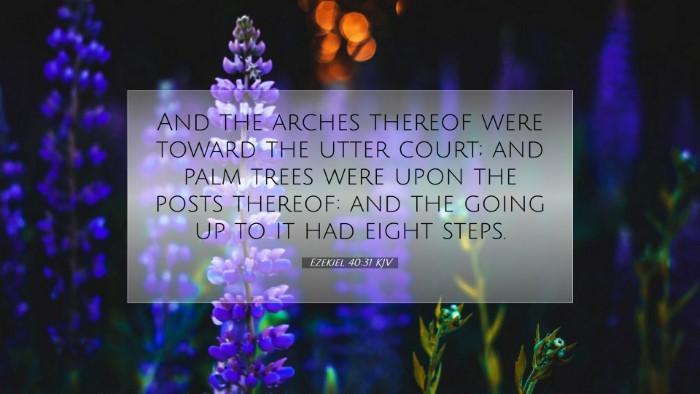Bible Commentary on Ezekiel 40:31
Verse Text: "And the arches thereof were toward the outer court; and palm trees were upon the posts thereof: and the going up to it had eight steps."
Introduction
This verse is situated within the larger context of Ezekiel's vision of the new temple and its surrounding structures. It provides a detailed account of the measurements and aspects of the temple, which symbolize God's relationship with His people and the renewal of worship. Understanding this passage requires delving into its historical background, symbolism, and theological implications.
Contextual Analysis
The book of Ezekiel, written in the sixth century BC during the Babylonian exile, combines prophetic oracles with visionary experiences. Chapter 40 marks the beginning of Ezekiel’s vision of a future temple, emphasizing restoration and hope for Israel. This vision serves as a blueprint for the spiritual renewal of the people following exile.
Commentary from Key Scholars
Matthew Henry
Matthew Henry highlights the significance of this verse in the context of the temple's architecture. He notes that the "arches" symbolize the structural integrity and the divine order around the worship space. Henry points out that the presence of palm trees signifies both beauty and victory, as palms were often associated with triumph and festivity in Jewish culture.
Albert Barnes
Albert Barnes provides insight into the construction details, emphasizing that the design of the temple and its approaches was meticulously planned. He explains that the "outer court" represents an accessible area for the congregation, reinforcing the idea of community participation in the worship process. The eight steps leading up to the temple signify progression and elevation, both physically and spiritually, as worshippers approach the holiness of God.
Adam Clarke
Adam Clarke offers an in-depth exploration of the number "eight," which often represents new beginnings in the Bible. He interprets the eight steps as a call to progression in faith and a reflection of the ultimate commitment required to approach God’s presence. Moreover, Clarke discusses the presence of palm trees as an encouragement to the exiled Israelites, reminding them of their heritage and the joy of future restoration.
The Symbolism of the Arches
The "arches" themselves can be viewed as a representation of the covenant between God and His people. They form a structure that supports and protects what lies within — a metaphor for God’s safeguarding of His chosen ones. In a spiritual sense, these arches underscore the importance of commitment, as one must pass under them to enter the holy space, symbolizing the necessity of obedience and faithfulness.
The Role of Palm Trees
Palms, historically associated with joy and celebration, suggest a future hope and restoration for the Israelites. In the context of the temple, they not only beautify the entrance but also encourage a mindset of triumph over adversity. The imagery of palm trees can further be linked with the idea of righteousness flourishing in God’s presence, as believers are called to bear fruits of the Spirit.
Spiritual Insights
Worship and Accessibility: The design of the temple's approach, especially with the eight steps, illustrates God's desire for His people to come near to Him. Access to God’s presence is essential in both the Old and New Testaments, echoing the invitation to approach God through Christ.
Holiness and Preparation: The steps leading up to the temple not only indicate the physical act of drawing near but prepare the worshippers spiritually. This preparation involves recognizing one’s sinfulness and the need for purification before an encounter with holiness.
Theological Implications
This passage resonates with the New Testament themes of redemption and access to God. Just as the temple represents a place where heaven meets earth, believers today find their temple in Christ, where they are called to worship in spirit and truth (John 4:24). The steps and the arches serve as a reminder of the journey of faith, marked by both ascent and the beauty of God’s presence.
Conclusion
Ezekiel 40:31 serves as a powerful testament to the hope and restoration awaiting the people of God. The detailed construction of the temple informs not just the physical aspects of worship but also shapes the spiritual life of the faithful. As pastors, students, theologians, and scholars delve into this verse, they are invited to reflect on their own approaches to worship and the ultimate accessibility they have through Christ.


